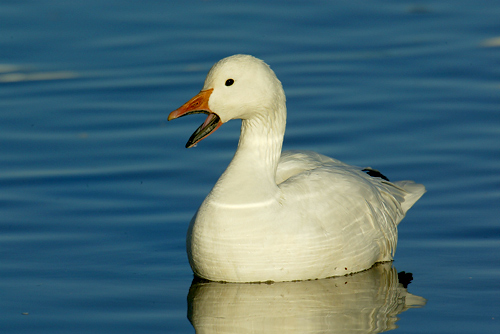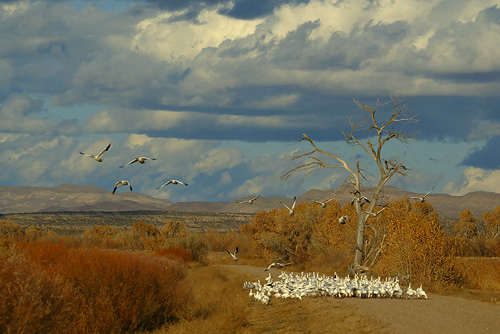IPT TESTIMONIAL
Here is part of a
letter that I received from Todd and Jackie Schneider who joined
me and 8 others on the post-X-mas SW Florida IPT recently:
"Dear Art....
I wanted to commend and congratulate
you on the "Putting Art in Your Nature Photography" slide show
that was presented after the first day of shooting. I know that
you were feeling absolutely horrible and could barely speak, but
that didn't matter. The images spoke for themselves. I want to
tell you that those images really knocked my socks off. Ask
anyone who knows me and they'll tell you that I never get excited
about anything. But ask Jackie about my thoughts on this
particular slide show and she'll tell you that I was very excited
and genuinely impressed. I see the images in the latest
photography magazines and they're good, but are all too often the
same old ho-hum stuff. But your images were not just about birds,
but about "nature" and how best to capture it. Just so you know,
Jackie and I refer to this slide show as the "making something out
of nothing slide show" because of the many examples where you
made great photographs in situations where so many others couldn't
"see" anything. That to me is a true testament to your
understanding and ability as a nature photographer, as well as a
bird photographer. I think the "something out of nothing" idea is
what impacted me the most. Honestly, I could sit through that
slide show one hundred times and not get bored by it. I truly
hope I get another opportunity to see that slide show again.
The IPT elevated my enjoyment and energy for nature photography to
a new level. My only regret is that there wasn't more time. More
time to share stories with the great people, and especially more
time out in the field. It all went by so quickly. There was so
much to see and do each and every day. Looking back, I would
have been perfectly happy to spend all three days just in Little
Estero Lagoon. I can't wait to go back some day! In the
meantime, I'll have to keep working to improve my photography, try
to stay up on digital for the inevitable switch-over one day, and
find some way, some how to get out there to do more and more
shooting. One thing is for sure. Going back to the old desk job
will be tougher than ever before.
Well, I'd better wiggle on out of here. Again, thanks so much
for everything. The IPT was a great success, and we certainly
hope to do it again real soon. Perhaps Bosque next time!"

Snow Goose squawking, Bosque Del
Apache NWR, New Mexico
Digital capture: EOS 1D, 600mm f/4L IS
lens, 2X II TC
ISO 200, Evaluative Metering -2/3
stop: 1/1000 sec. at f/11
Image copyright 2002 Arthur
Morris/BIRDS AS ART
Notice that more underexposure
was needed for digital than for film (where -1/3 stop would be
correct).
MYSTERY SOLVED
For years, I have had to deal
with an extremely frustrating problem with my Canon 100-400mm IS
zoom lens: when using the lens handheld with the IS turned on, the
electrical contact between the lens and the camera was often
severed. I would press the shutter button with a great flight or
action image in the viewfinder, but the camera would not fire. The
viewfinder display would black out. When I looked at the LCD atop
the camera, it would show "Av: 00." I would be forced to unmount and
then remount the lens. Sometimes this helped, and sometimes it did
not. At times, switching to a new battery and/or cleaning the
contacts helped, but at other times these actions did not help. I
have run into several folks on IPTs who have had similar problems
both with the 1-4 IS and with other IS lenses, and others have
contacted me for help with this or similar problems via e-mail.
I spoke to many of
the technical folks at Canon who suggested the following at various
times: clean the contacts, put in fresh batteries, make sure that
the lens is firmly supported so that the electrical contact is
maintained. It was suggested at times that the high voltage
requirements of the IS lenses taxed the lower end camera bodies
beyond their electrical capabilities. Having the same problems with
EOS 1V and the EOS 1D ruled out the latter as a solution. About two
weeks ago I spoke with Jerry Moore at the Canon Jamesburg, NJ Repair
Facility. He listened carefully to my story and said, "It sounds
like a faulty IS system. Send it in. I did, had the lens Fed-Xed
to me in California, and was delighted to find that the lens
functioned perfectly. Here is the contact
information: Canon Factory Service, 100 Jamesburg Road, Jamesburg,
NJ 08831. (732) 521-7000 or (732) 521-7888.

Snow Geese on the road... Bosque Del
Apache NWR, New Mexico
Digital capture: EOS 1D, 100-400mm zoom @ 200mm.
ISO 100 Evaluative Metering -1/3 stop: 1/1250
at f/6.3
Image copyright 2002 Arthur Morris/BIRDS AS ART
Note the amazing verstility of the
Canon 100-400mm L IS zoom lens by comparing this image with that of
the "Sandhill Cranes pair in flight" image above.
DELKIN FLASH
CARDS
When I first began using a digital camera on a full time basis,
I thought that a flashcard was a flashcard was a flashcard.
Silly me. I have since learned that the speed of the card
affects how quickly you can resume making photographs in rapid
fire mode once the buffer is full, and how fast you are able to
review the images. On my recent California trip, I had the
opportunity to field test the Delkin 640 mb e-Film PRO Compact
Flash card, and I was most impressed. I pretty much filled the
two 640 cards each morning and afternoon, and they performed
flawlessly. The cards not only allowed me to shoot long bursts
with the Canon EOS 1D (tests have shown that as many as 19
consecutive images may be made on a fresh card without pause),
but allowed for a quick review of the histograms as well. In
addition, they downloaded to my laptop at a faster rate than the
512 Transcend cards that I had been using.
I was not amazed to learn that the Delkin 640
cards had the very fastest
write-speeds for both the Canon 1Ds and the Canon EOS D-60
camera bodies, and were just an eyelash behind the renowned
Lexar top-of-the-line cards with the 1D. And this was not just
manufacturer's hype, but the actual results of independent tests
by Roger Galbraith, a highly respected digital photojournalist
and consultant. You can see the results of these and
other similar tests at:
You will surely enjoy tooling around the rest of
this amazing, information-packed digital photography site after
checking out the test results for yourself.
For more information on the Delkin 640 mb e-Film
PRO Compact Flash cards themselves, visit:
Do know that Alan Parry of Delkin generously sent me four 640 mb
flash cards for field testing. Thank you, Alan!
See the Hunt's Specials below for
a great price on these cards.
Snow Goose
backlit, Bosque Del Apache NWR, New Mexico
Digital capture: EOS 1D,
2XII TC, EF 600mm f/4 L IS lens
ISO 200 Evaluative
Metering +1 stop: 1/500 sec. at f/8
Image copyright 2002
Arthur Morris/BIRDS AS ART
One thing that
very few folks realize about joining photo tours is that it gives
them the opportunity to see how a creative leader thinks. After
telling my group for two days that the wind and the light and the
flight patterns of the birds were all wrong, I had a brainstorm
and managed to get us in position to make great images of
backlit Snow Geese landing. When someone said, "That was
brilliant!" I responded by saying "If that's true, then why did it
take me so long to figure it out?" Note also that flight
photography with the 1D and an effective focal length of 1560 mm
(1200mm X 1.3) is a viable option...
AIR
TRAVEL INFO
NW and
American Airlines have instituted a $25 charge for bags weighing
more than 50 pounds but less than 70 pounds. (There is and has
been for quite some time a much steeper charge for bags over 70
pounds.) On my recent American flights to and from San Diego I
was not charged in spite of the fact that both of the bags on each
leg were well in excess of the new 50 pound limit. I am not sure
if this was simply an oversight (I used curb-side check-in both
times and recommend that you do the same if possible whenever
flying) or if I was not charged because I was flying first class.
Another
pleasant surprise was that even though I changed my return flight
before heading to San Diego, this did not trigger a dump-search of
my checked bags as it had always done in the past. This is almost
surely due to the implementation of the new security procedures
for all checked baggage. This brings us to the following which
has been excerpted and adapted from an e-mail from Eugene Mopsik,
Executive Director of ASMP (American Society of Media
Photographers) of which I am a member:
With regards to locked
bags: Equipment cases may be locked. When you arrive at the
airline's ticket counter to check your bags, you will be asked if
your bags are locked. When you answer "Yes" you will be handed a
TSA notice requesting that for security reasons you unlock your
bags. Ask for a TSA supervisor or air carrier supervisor and
identify yourself through your business card (and ASMP membership
card if applicable) as a working professional photographer. Let
them know that your cases are
locked, however, give them your name and cell phone number in the
event that the cases need to be opened. Also, make sure that your
Passenger Name Record includes a notation of your professional
status and that you are available to open the cases for
inspection. Place a sticker on your cases with your name and cell
phone number indicating that you are available to unlock the
cases. Place a notice inside each case indicating that the
contents represent sensitive professional equipment and that you
would appreciate all care with inspection and repacking. TSA does
not want to damage your cases, however they may want to inspect
the contents. Be patient, be polite, and be professional.
TSA was very responsive to the issues affecting ASMP members. TSA
has requested that in the event of a "horror story" involving an
ASMP member, that the information be sent to ASMP for forwarding
to TSA. Please send any such information to
Mopsik@asmp.org. (I have
e-mailed Eugene and asked him how the above affects professionals
traveling with photographic equipment that is packed in checked
bags along with clothing and other personal items. I shall share
his response with you when I hear from him.)
ASMP is the leading trade
association for photographers who photograph primarily for
publication. ASMP promotes photographers' rights, educates
photographers in better business practices, produces business
publications for photographers and helps buyers find professional
photographers.ASMP was founded in 1944 by a handful of the world's
leading photojournalists and is recognized internationally for its
leadership role. ASMP has over 5,000 members, including many of
the world's greatest photographers, in 40 chapters nationwide. To
learn more about ASMP or to join, visit:
http://www.asmp.org
(If you sell your images on a
regular basis, it is in your very best interests to join ASMP; AM.)